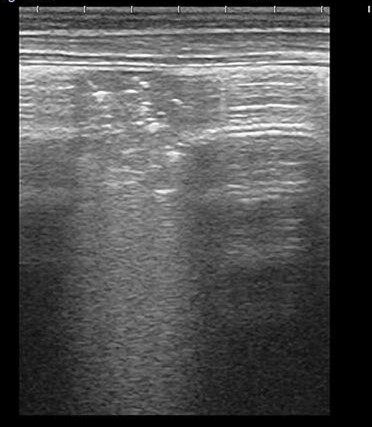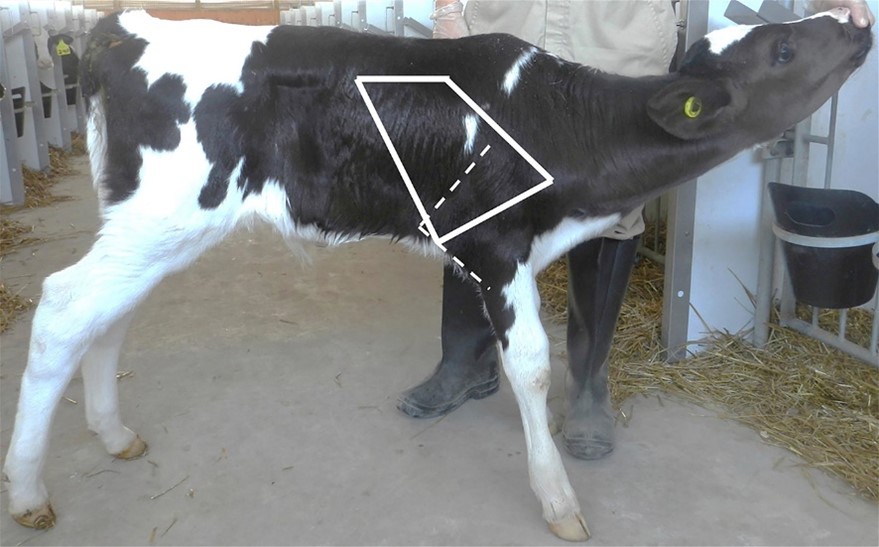Bovine respiratory disease (BRD) is common in cattle youngstock on dairy farms. The current diagnostic methods lack sensitivity and specificity. Auscultation of the lung fields was found to have a sensitivity (Se) of 63% and a specificity (Sp) of 46%,8 and analysis of demeanour, appetite, respiratory character and temperature in young calves had a Se of 62% and Sp of 63% for BRD diagnosis. Thoracic ultrasound is a relatively new BRD diagnostic tool with increased accuracy. Thoracic ultrasound can identify a variety of BRD lesions such as consolidation, abscesses and free pleural fluid. The size of lesions can be measured and scored using a standardised system. Furthermore, thoracic ultrasound has also been reported as a more sensitive and specific method for detecting BRD, with an Se of 76%–94% and Sp of 93%–100%.
A pilot test was implemented on an experimental farm of Warsaw University of Life Sciences.
 Thoracic ultrasound can be undertaken using an ‘EasyScan Go’ ultrasound scanner with linear probe (IMV Imaging, Bellshill, UK). The lung fields are scanned by moving the probe from a caudo-dorsal to cranio-ventral direction from rib spaces 10 to 6 on both sides, then each calf is given a thoracic ultrasound score on an 0–5 scale based on a standardised lesion identification and scoring system previously described. A normal thoracic ultrasound score is defined as ≤1 and abnormal scores as >1. The prevalence of abnormal thoracic ultrasound at farm level can be calculated for each of the two examination visits for each farm. Calf treatment data from the farm records were collected for analysis after scanning was performed. Treatments were classified as any antimicrobial product given to a calf by the farmer for perceived BRD prior to thoracic ultrasound examination. Farmers identified calves for treatment based on observation of clinical signs.
Thoracic ultrasound can be undertaken using an ‘EasyScan Go’ ultrasound scanner with linear probe (IMV Imaging, Bellshill, UK). The lung fields are scanned by moving the probe from a caudo-dorsal to cranio-ventral direction from rib spaces 10 to 6 on both sides, then each calf is given a thoracic ultrasound score on an 0–5 scale based on a standardised lesion identification and scoring system previously described. A normal thoracic ultrasound score is defined as ≤1 and abnormal scores as >1. The prevalence of abnormal thoracic ultrasound at farm level can be calculated for each of the two examination visits for each farm. Calf treatment data from the farm records were collected for analysis after scanning was performed. Treatments were classified as any antimicrobial product given to a calf by the farmer for perceived BRD prior to thoracic ultrasound examination. Farmers identified calves for treatment based on observation of clinical signs.
Use of thoracic ultrasound on calves may increase detection rates and help identify farms where diagnosis of BRD is inaccurate. Demonstrating the ‘true’ impact of BRD on farm may be of value in demonstrating the need to implement preventive healthcare strategies, and subsequently improve calf health and welfare. Thoracic ultrasound has also been reported as a more sensitive and specific method for detecting BRD, with an Se of 76%–94% and Sp of 93%–100%.

Thoracic ultrasonography in young cattle has recently gained momentum as an accurate and practical tool for identifying the lung lesions associated with bovine respiratory disease. As cattle producers increasingly seek input from their veterinarians on respiratory health issues, bovine practitioners should consider adding thoracic ultrasound to their practice models, said Dr. Bartosz Pawliński.
Further information
https://bvajournals.onlinelibrary.wiley.com/doi/full/10.1002/vetr.939